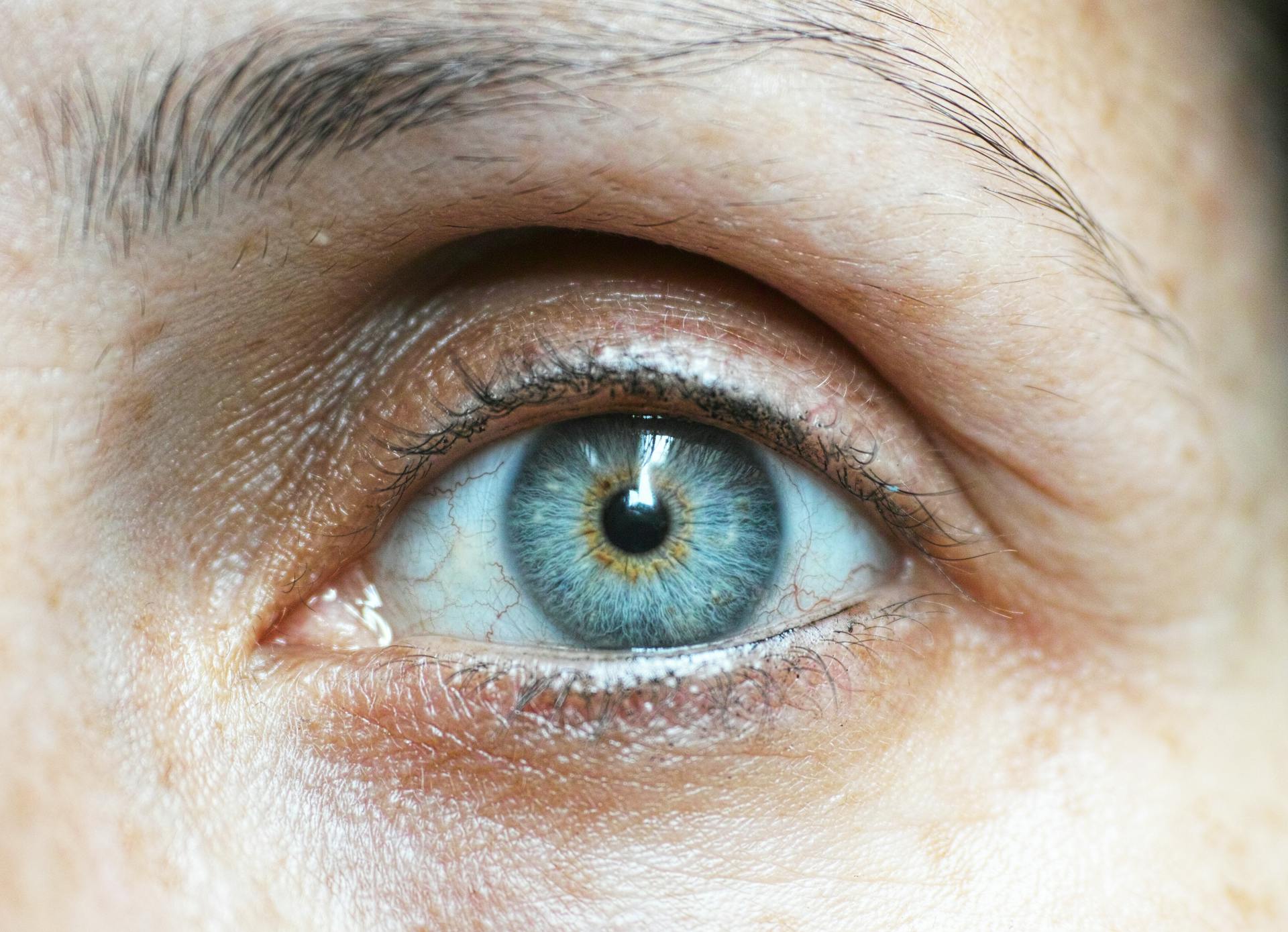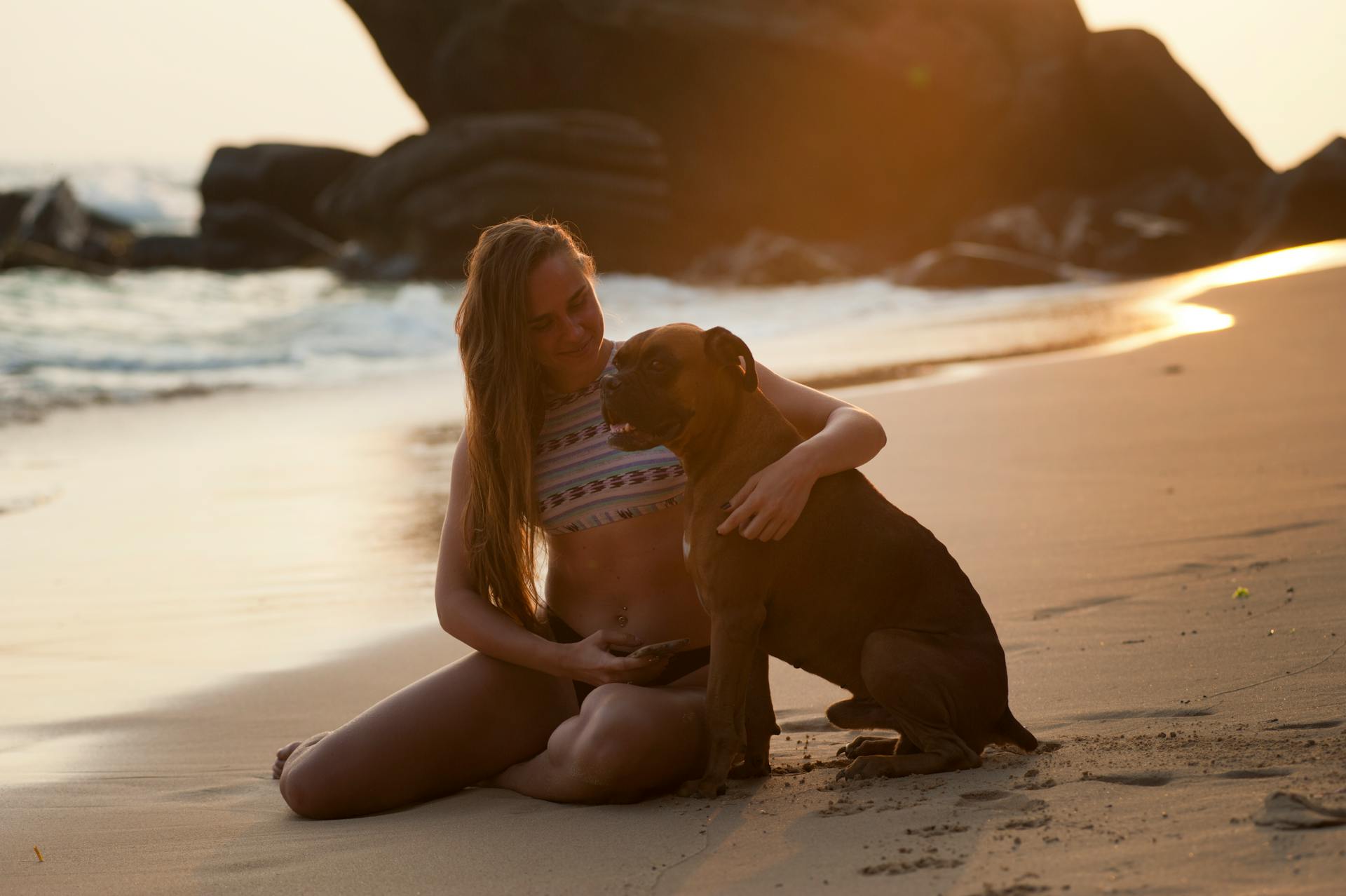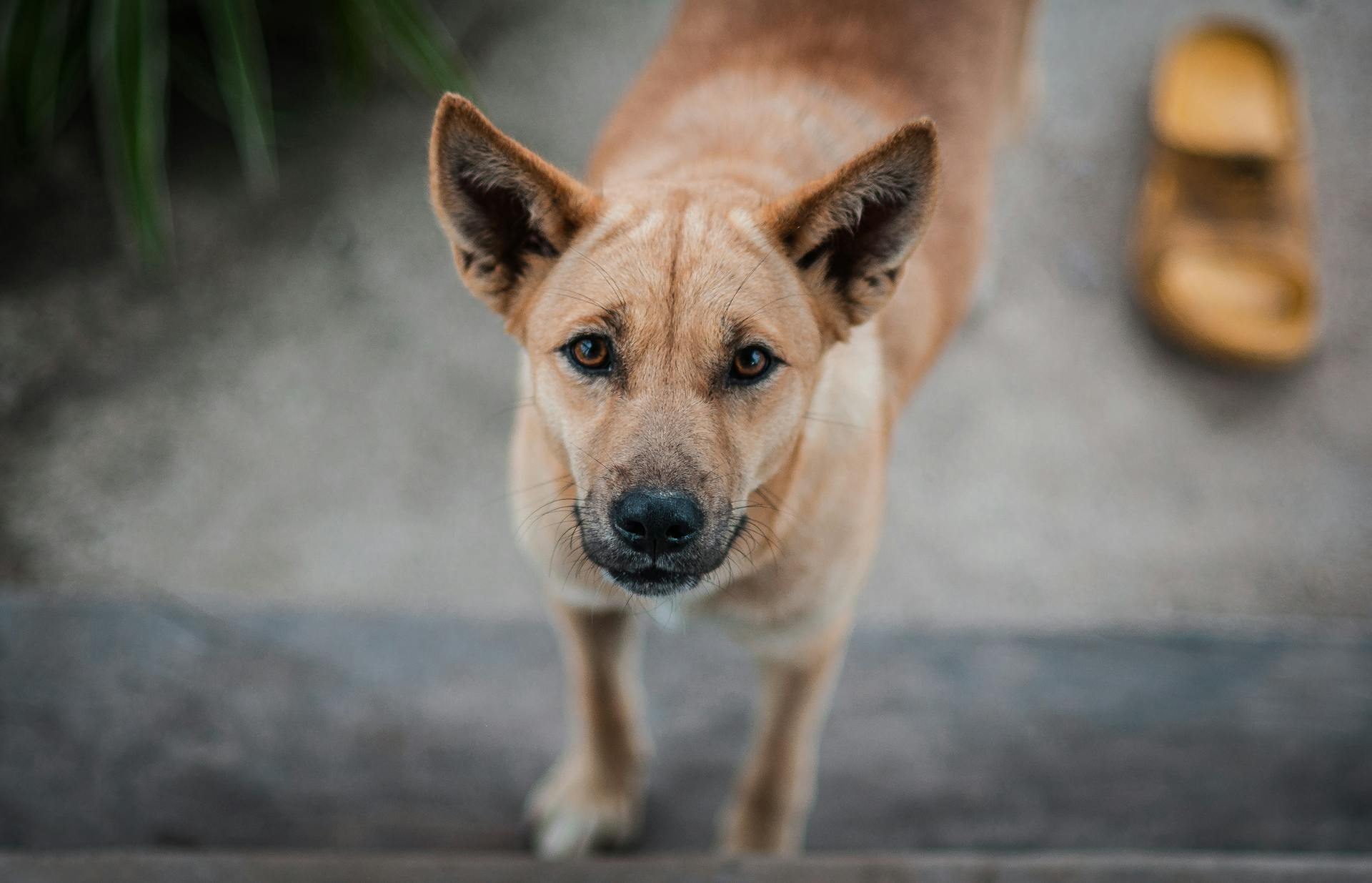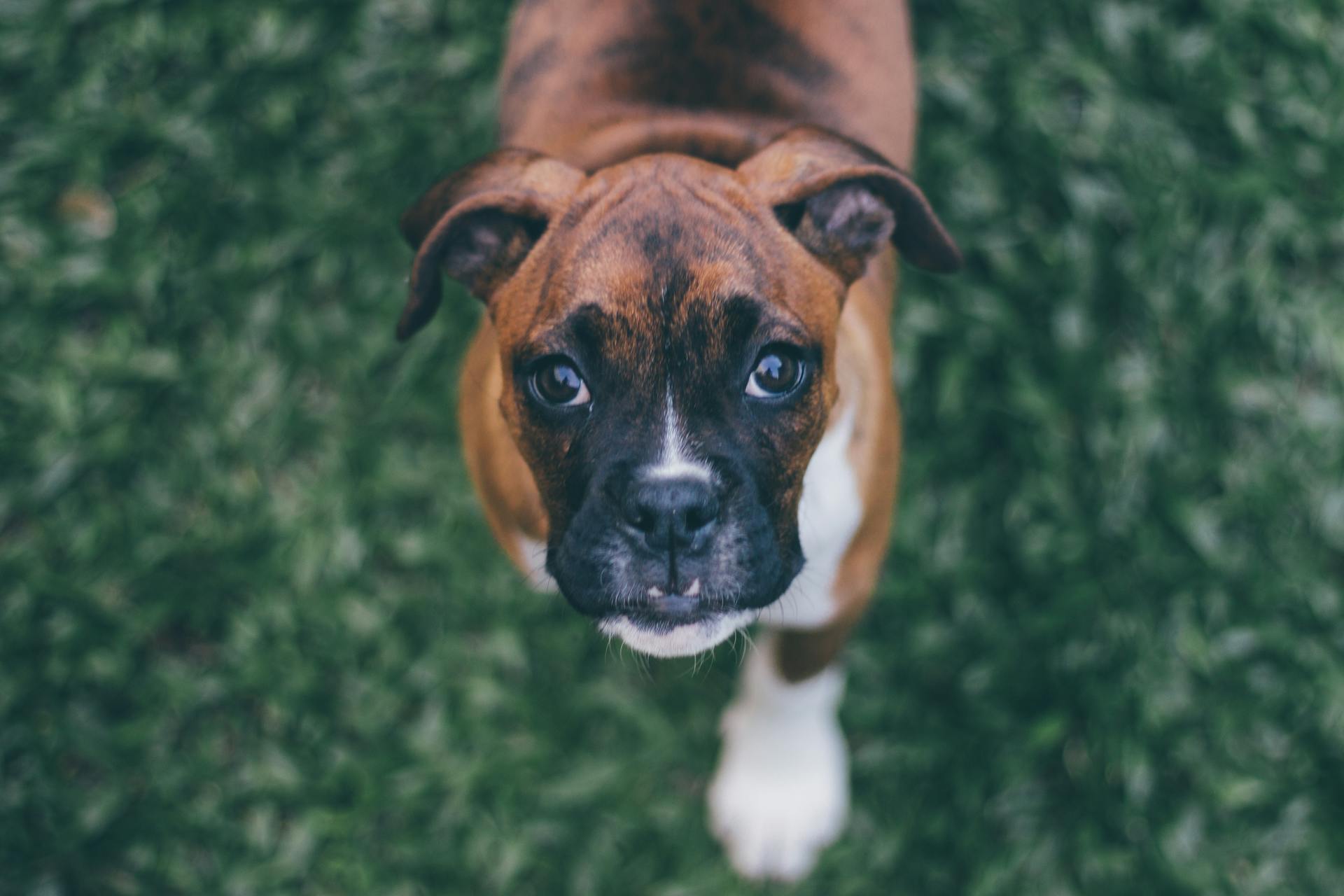
Boxers are prone to eye problems, particularly in their first few years of life. The most common issue is progressive retinal atrophy, which can lead to blindness.
This condition is often inherited from the parents, so it's essential to work with a reputable breeder who has had their dogs tested for genetic issues. Regular check-ups with your veterinarian can help catch any problems early on.
Boxers are also susceptible to entropion, a condition where the eyelid rolls inward, causing irritation and discomfort. This can be caused by genetics, injury, or even allergies.
Eye Problems in Boxers
Eye problems in Boxers can be a concern, especially as they age. Cloudy eyes in Boxers are often a sign of aging, but they can also be a symptom of other eye issues.
Nuclear sclerosis, a condition that causes a cloudy, bluish discoloration in the lens, is common in older dogs, including Boxers. This condition doesn't significantly diminish vision, but it can affect both eyes at the same time.
Worth a look: Cloudy Eye
Some breeds, like Boxers, are more susceptible to certain eye problems, such as cataracts. Cataracts are caused by abnormal lens metabolism and can lead to vision loss. If left untreated, cataracts can cause total blindness.
Here are some common eye problems that can affect Boxers:
- Cataracts
- Nuclear sclerosis
- Glaucoma
- Anterior uveitis
- Corneal dystrophy
These conditions can be painful and cause vision loss, so it's essential to monitor your Boxer's eye health and consult with a veterinarian if you notice any changes.
Glaucoma
Glaucoma is a painful condition that occurs when the pressure inside the eye increases, resulting in damage to the structures in the eye.
This condition is a veterinary emergency, as it can lead to permanent damage to the optic nerve and vision loss. High intraocular pressure can cause a dog's eyes to become red and irritated, and may also cause a bulge to the eye.
Some breeds of dogs, including Beagles, Cocker Spaniels, and Siberian Huskies, are more susceptible to inherited glaucoma.
In addition to a cloudy eye, other symptoms of glaucoma may include a blue or red tint to the cloudiness, increased discharge, squinting, and a dilated pupil.
Prompt diagnosis is essential, as glaucoma can lead to serious consequences if left untreated. A tonometer is used to diagnose glaucoma, and treatment may vary depending on whether the glaucoma is primary or secondary.
In cases where medication fails, your veterinarian may recommend laser therapy, eye removal, implants to facilitate drainage, gentamicin injections, or cyclocryotherapy to reduce intraocular fluid production.
It's essential to work closely with your veterinarian to determine the best course of treatment for your dog's glaucoma.
Anterior Uveitis
Anterior uveitis is a serious condition that can affect Boxers, causing a cloudy appearance in their eyes. It's a type of inflammation that affects the uvea, the tissue at the front of the eye.
Anterior uveitis can be caused by various factors, including autoimmune disease, cancer, trauma, metabolic disease, parasites, and fungal, viral, and bacterial infections. These causes can be complex and may require diagnostic tests to determine the underlying issue.
Symptoms of anterior uveitis include redness, discharge, squinting, an oddly shaped pupil, eyeball swelling, excessive tearing, and a cloudy or dull appearance. If you notice any of these signs in your Boxer, it's essential to consult with a veterinarian promptly.
Left untreated, anterior uveitis can lead to irreversible vision loss, making prompt treatment crucial. Treatment may involve eye drops, eye ointments, and oral medications, depending on the underlying cause.
Here are some potential causes of anterior uveitis in Boxers:
- Autoimmune disease
- Cancer
- Trauma
- Metabolic disease
- Parasites
- Fungal, viral, and bacterial infections
Corneal Dystrophy
Some dogs develop a condition called corneal dystrophy, which gives their cornea an opaque, cloudy appearance.
This common condition is inherited and can be uncomfortable for dogs. Shetland Sheepdogs appear to be the most susceptible breed.
Stromal corneal dystrophy affects the middle layer of the cornea and can be found in Airedale Terriers, Cocker Spaniels, Cavalier King Charles Spaniels, Samoyeds, and Weimaraners.
Dogs with endothelial corneal dystrophy are typically middle-aged or older and can be genetically predisposed to this condition. Boston Terriers, Chihuahuas, and Dachshunds are some breeds that may be more prone to this type of dystrophy.
The veterinarian will use a microscope with a bright light and a fluorescein stain to examine the details of the eye, and may prescribe antibiotic eye medications.
Both epithelial and endothelial cornea dystrophy can cause ulcers that require treatment, but there is no cure for corneal dystrophy.
Recommended read: How to Breed Yorkshire Terriers
Eye Discharge and Infection
Eye discharge in boxers is a common issue that can be caused by various factors. It's essential to recognize the signs and symptoms of eye infections to prevent more serious problems.
Dog eye discharge varies in color and consistency, and its appearance can help determine why it's happening. Conjunctivitis, also known as pink eye, is a common issue in dogs, but it's not the same as human pink eye. Dogs with pink eyes are likely experiencing another cause of inflammation.
Some common eye problems that lead to discharge in boxers include conjunctivitis, eye infections, allergies, corneal ulcers, dry eye, glaucoma, entropion, and ectropion. These conditions can cause redness, cloudiness, squinting, or rubbing at the eyes.
If your boxer has significant eye discharge, it's crucial to contact your veterinarian. Anything more than small eye boogers or crust should be reported to your vet, especially if it lasts more than a few days. Left untreated, eye problems can quickly become serious.
Intriguing read: Types of Dog Eye Infections
Here are some common signs of eye infection in boxers:
- Redness
- Cloudiness
- Squinting
- Rubbing at the eyes
- Discharge
If you notice any of these symptoms in your boxer, it's essential to seek veterinary attention promptly. Your vet may prescribe medicated eye drops or ointment to treat the eye condition, or in severe cases, oral medications may be necessary.
Eye Care and Treatment
Dry eye, or keratoconjunctivitis sicca, is a common issue in dogs, and Boxers are no exception. It occurs when a dog's body doesn't produce enough tears, leading to irritation and potentially even ulcers.
Some breeds, like Yorkshire Terriers and Pugs, are more susceptible to dry eye, but it can affect any dog. Boxers may be prone to dry eye due to their facial structure.
Symptoms of dry eye include mucous discharge, redness around the whites of the eye, swelling of the tissue on the surface of the eye and eyelids, and squinting or excessive blinking. Watch your Boxer closely for these signs.
Dry eye can usually be treated with tear-stimulating medications and topical antibiotics. In severe cases, surgical options may be necessary to promote increased tear production.
It's essential to have your Boxer's cloudy eyes checked by a veterinarian to determine the underlying cause. Treatment will depend on the cause, age, and severity of the condition.
If your Boxer has cloudy eyes, it's crucial to monitor their eye health closely and contact your veterinarian as soon as possible if you notice redness, squinting, or thick discharge.
Mild eye discharge in Boxers can often be managed at home with gentle cleaning and over-the-counter drops. However, if your dog is in pain or showing other signs of eye issues, it's best to consult with your veterinarian for further guidance.
When administering eye drops, face your Boxer forward and hold the bottle in your right hand, resting your wrist on their head. Apply drops before ointments, and wait five minutes between each application.
If your Boxer has ectropion, a sagging or outward rolling lower eyelid, it may require lubricating eye drops or ointments to prevent drying out of the cornea and conjunctiva. In severe cases, surgery may be necessary to correct the condition.
Regular veterinary check-ups can help prevent more serious eye issues from developing. Pay attention to any changes in your Boxer's eye health, and don't hesitate to reach out to your veterinarian if you notice anything unusual.
A different take: Boxer Breed Health Problems
Ectropion and Other Conditions
Ectropion occurs when your dog's lower eyelid rolls away from the eye, causing a droopy appearance and exposing the delicate mucous membrane or conjunctiva.
This condition can be caused by various health issues such as nerve damage, infection, injury, or severe chronic inflammation of the eye. In some cases, ectropion has been selectively bred into many modern dog breeds, including boxers.
Symptoms of ectropion may include a discharge, red and inflamed conjunctive lining of the eyelid, and tearing, which can lead to brown staining of the fur below the eye. If your dog is pawing and rubbing at their eye, or the eye is watering, it could be a sign of ectropion.
If left untreated, ectropion can lead to painful conditions such as pink eye (conjunctivitis), corneal inflammation (keratitis), corneal scarring, and possible visual impairment. It's essential to keep an eye out for any unusual eye discharge or signs of pain in your boxer.
Here are some common eye problems that can cause discharge in dogs:
- Conjunctivitis (pink eye)
- Eye infections
- Allergies
- Corneal ulcers or other corneal injuries
- Dry eye (KCS)
- Glaucoma
- Entropion
- Ectropion
- Distichia
- Cherry eye
- Foreign object in the eye
- Growth on the eyelid or in the eye, such as a cyst or tumor
If you notice any of these symptoms in your boxer, contact your veterinarian as soon as possible. Remember, it's always better to be safe than sorry when it comes to your furry friend's eye health.
Frequently Asked Questions
What are Boxer ulcers in dogs eyes?
Boxer ulcers, also known as indolent ulcers, are a common eye disorder in dogs characterized by chronic corneal epithelial defects that don't heal on their own. They are often referred to by other names, including SCCEDs and persistent corneal erosions.
Sources
- https://www.akc.org/expert-advice/health/cloudy-eyes-in-dogs/
- https://www.dailypaws.com/dogs-puppies/health-care/dog-conditions/dog-eye-discharge
- https://www.petmd.com/dog/breeds/boxer
- https://www.greensboro.carolinavet.com/site/greensboro-specialty-veterinary-blog/2020/11/02/ectropion-red-droopy-eyes-in-dogs
- https://www.cherrydownvets.co.uk/news/breed-related-diseases-in-dogs-boxer/
Featured Images: pexels.com


